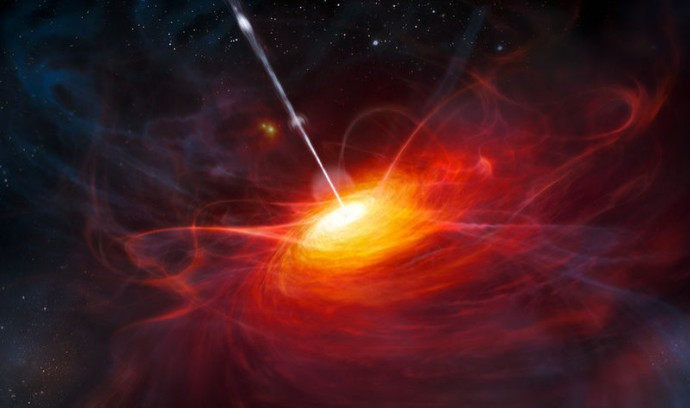Quaser quartet baffles astronomers: 4 active black holes spotted in distant region of universe

Astronomers at the Max Planck Institute for Astronomy in Heidelberg, Germany have made an amazing discovery in a distant region of the universe: four quasars - active black holes - in a strange cluster "only" 700,000 light years apart.
A quasar - or "quasi-stellar radio source" - occurs when a super-dense black hole at the centre of a galaxy sucks in dust and gas debris, emitting a light up to a trillion times brighter than our sun and brighter than the entire galaxy that hosts them.
Quasars are hard to find as they have a relatively short lifespan - typically 10m to 100m years. The average distance between two quasars is 100m light years, so to find four within such a relatively small patch of sky is remarkable.
Dr Joseph Hennawi, who led the study, said the chances of finding four quasars together was incredibly small.

"The primary significance of the quadruple-quasar system is the extremely low probability of a discovery like this occurring by chance, according to our current understanding of the abundance of quasars," Hennawi told Space.com.
"We thus either have to conclude that we got really lucky - 1 in 10m - or that quasar activity is much more likely to occur in certain environments. That, in turn, could be an important piece of the puzzle for understanding what makes a galaxy turn on as a quasar."
The four quasars are located within an unusual giant cloud of gas - the "jackpot nebula" - in which are located hundreds of times more galaxies than should be the case, making it a "super-cluster" of galaxies. Because light from the region took 10bn years to reach Earth, we are viewing events which took place just four billion years after the Big Bang.
The discovery of the quasars and jackpot nebula in gas far cooler than had previously been predicted means astronomers will now attempt to find similar phenomena elsewhere in the universe in order to see how and why they are related.
"We were searching for giant nebulae associated with massive amounts of cool gas, and then basically stumbled upon this quadruple quasar," said Hennawi.
"Since discovering a quadruple quasar is so unlikely, we conclude that giant nebulae of cool gas, proto-clusters and quasar activity are all interrelated somehow."
© Copyright IBTimes 2025. All rights reserved.






















